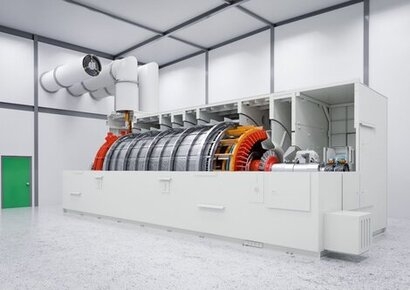
ESB recently announced the launch of Green Atlantic @ Moneypoint, an ambitious plan to transform the County Clare site into a green energy hub, where a range of renewable technologies will be deployed over the next decade with the capacity to power 1.6 million homes.
The synchronous condenser, a key component of ESB’s Green Atlantic @ Moneypoint project, will be the first in the country and incorporate the world’s largest flywheel used for grid stability. The facility will enable an increased integration of wind power into the Irish grid by providing sufficient inertia for frequency support, short-circuit power for system strength and reactive power for voltage control. Commissioning of the new plant is planned for mid-2022.
“Due to the intermittency of wind energy in particular, grid stabilisation technologies have an increasingly important role in a successful energy transition” said Paul Smith, Head of Asset Development at ESB Generation and Trading. “We are pleased to bring forward the Moneypoint Synchronous Compensator with flywheel as a cost effective and zero carbon solution in strengthening the stability and resilience of the Irish grid. Siemens Energy provided an optimum technical and competitive solution for Moneypoint in its continuing key role in Ireland’s electricity system.”
Siemens Energy will deliver the synchronous condenser system, providing engineering, procurement, and construction. Key components are a control system which optimally fits to the overlaying grid automation system, a synchronous generator with circuit-breaker and a flywheel. In addition, Siemens Energy will provide the preventive maintenance for ten years with remote diagnostics. The synchronous condenser will, in turn, help management of Ireland’s transmission system with a reduced dispatch of fossil fuel plant under constraints and reduced costs of transmission operations.
With the rising share of renewable power and the shutdowns of conventional plants, synchronous condensers are playing an increasingly important role in the grid. By means of the rotating mass of a conventional generator, the solution adjusts conditions on the transmission grid, provides the necessary inertia to support the grid frequency and short-circuit contribution while also providing or absorbing reactive power. In addition, synchronous condensers can diversify revenue for owners and operators while providing an important cash flow contribution.
For additional information:

